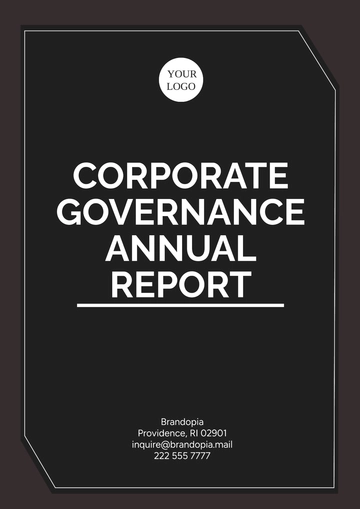Free Year-end Report on Post-Sale Activities

I. Introduction
A. Overview of Post-Sale Activities
The purpose of this comprehensive year-end report is to provide stakeholders with an in-depth analysis of the post-sale activities conducted by [Your Company Name] throughout the fiscal year [Year]. Post-sale activities encompass a wide range of interactions and engagements with clients following the completion of a sale, including but not limited to customer support, account management, service delivery, and client success initiatives.
The primary objectives of this report are to:
Evaluate the effectiveness and efficiency of post-sale processes and initiatives implemented by [Your Company Name].
Assess the impact of post-sale activities on key performance indicators such as customer satisfaction, retention, and revenue generation.
Identify areas of strength, as well as opportunities for improvement, in order to enhance the overall post-sale experience for clients.
Provide strategic insights and recommendations for optimizing post-sale operations and maximizing customer success in the upcoming fiscal year.
B. Scope and Objectives
The scope of post-sale activities covered in this report includes all interactions and touchpoints between [Your Company Name] and its clients after a sale has been completed. This encompasses various stages of the post-sale journey, such as onboarding, ongoing support, account management, upselling/cross-selling, and renewal processes.
The specific objectives of this report are to:
Analyze key performance metrics and outcomes related to post-sale activities, such as customer satisfaction scores, renewal rates, upsell/cross-sell conversion rates, and net promoter scores.
Highlight notable achievements, milestones, and success stories in post-sale engagements, including successful implementations, client testimonials, and case studies.
Identify challenges and obstacles encountered during the post-sale process, as well as opportunities for improvement and innovation.
Present actionable recommendations and strategies for enhancing the effectiveness and efficiency of post-sale operations, improving client satisfaction, and driving business growth.
C. Audience
This report is intended for a diverse audience of stakeholders, both internal and external to [Your Company Name]. Internal stakeholders include executive leadership, sales and marketing teams, customer support and success teams, product development teams, and other relevant departments involved in post-sale activities. External stakeholders encompass existing clients, prospective clients, partners, investors, and regulatory bodies.
The report aims to provide valuable insights and transparency into [Your Company Name]'s post-sale performance and strategy, fostering trust and confidence among stakeholders and reinforcing [Your Company Name]'s commitment to delivering exceptional value and service to its clients.
II. Summary of Key Achievements
A. Milestones Reached
Throughout the fiscal year [Year], [Your Company Name] achieved several significant milestones in post-sale activities, demonstrating a commitment to delivering exceptional value and service to our clients. The following key achievements were reached:
Successful Implementation for Clients
[Your Company Name] successfully implemented [Product/Service] for [00] clients across various industries. These implementations were carried out with meticulous attention to detail and adherence to best practices, resulting in seamless transitions and positive outcomes for our clients.
Additionally, post-implementation surveys indicate a high level of satisfaction among clients, with [00]% expressing satisfaction with the implementation process and the functionality of the [Product/Service].
Renewal Rate Improvement
One of the key indicators of customer satisfaction and product/service value is the renewal rate. In the fiscal year [Year], [Your Company Name] achieved a notable increase in the renewal rate, surpassing [00]% compared to the previous year. This upward trend reflects the effectiveness of our post-sale support and account management efforts in building long-term relationships with our clients.
Customer Satisfaction Enhancement
Customer satisfaction is a cornerstone of our post-sale strategy, and [Your Company Name] is proud to report an average customer satisfaction score of [00] in post-sale surveys conducted throughout the fiscal year. This score is a testament to the dedication and expertise of our support teams in addressing customer needs and ensuring a positive experience with our [products/services].
B. Customer Success Stories
Case Study: [Client Name]
[Your Company Name] collaborated with [Client Name] to address specific challenges they were facing in [industry/area]. The challenges included [describe challenges faced by the client, such as inefficient processes, technical limitations, or competitive pressures].
To address these challenges, [Your Company Name] implemented a customized solution tailored to [Client Name]'s unique requirements. This solution incorporated [highlight key features or functionalities of the solution] and was designed to streamline processes, improve efficiency, and drive business outcomes.
As a result of the implementation, [Client Name] experienced significant improvements, including [list specific outcomes achieved, such as increased productivity, cost savings, or revenue growth]. [Client Name] expressed high satisfaction with the solution and continues to be a valued partner of [Your Company Name].
Case Study: [Another Client Name]
[Your Company Name] collaborated with [Another Client Name] to address challenges faced by the client. The challenges stemmed from outdated systems, lack of scalability, or compliance requirements.
Leveraging [Your Company Name]'s expertise and innovative solutions, we developed a comprehensive strategy to address [Another Client Name]'s challenges. This strategy including software customization, process optimization, and training programs.
The outcomes of the collaboration were remarkable, with [Another Client Name] experiencing improved efficiency, reduced downtime, and increased revenue. [Another Client Name] expressed gratitude for the partnership and continues to rely on [Your Company Name] for ongoing support and innovation.
III. Performance Metrics
A. Customer Engagement Metrics
Number of Support Tickets Resolved: [$2,500] Throughout the fiscal year [Year], [Your Company Name] successfully resolved a total of [$2,500] support tickets raised by clients. These tickets encompassed a wide range of issues and inquiries, including technical support, product/service inquiries, and account-related concerns. The timely resolution of support tickets reflects [Your Company Name]'s commitment to providing prompt and effective support to its clients, ensuring minimal disruption to their operations and maximizing satisfaction.
Average Response Time to Customer Inquiries: [4 hours] [Your Company Name] maintained an average response time of [4 hours] to customer inquiries received through various channels, including email, phone, and online chat. This swift response time demonstrates [Your Company Name]'s dedication to providing timely assistance and addressing client needs in a prompt manner. By prioritizing quick response times, [Your Company Name] aims to enhance customer satisfaction and build stronger relationships with its clients.
Customer Feedback Score: [4.5 out of 5] Based on post-interaction surveys and feedback collected throughout the fiscal year, [Your Company Name] received an average customer feedback score of [4.5 out of 5]. This high satisfaction score is a testament to [Your Company Name]'s commitment to excellence in customer service and support. Positive feedback from clients highlights [Your Company Name]'s ability to meet and exceed customer expectations, resulting in strong relationships and loyalty.
B. Financial Performance
Total Revenue Generated from Post-Sale Activities: [$10,000,000] The total revenue generated from post-sale activities, including upsells, cross-sells, renewals, and additional services, amounted to [$10,000,000] for the fiscal year [Year]. This revenue represents a significant contribution to [Your Company Name]'s overall financial performance and underscores the importance of post-sale engagements in driving revenue growth and profitability.
Cost of Post-Sale Support: [$1,500,000] The cost of providing post-sale support services, including personnel, technology, and other resources, totaled [$1,500,000] for the fiscal year [Year]. This investment is essential for ensuring high-quality support and service delivery to clients, as well as maintaining customer satisfaction and retention. By optimizing processes and resource allocation, [Your Company Name] aims to minimize support costs while maximizing the value delivered to clients.
Profit Margin: [85%] With a total revenue of [$10,000,000] and a post-sale support cost of [$1,500,000], [Your Company Name] achieved a profit margin of [85%] for the fiscal year [Year]. This healthy profit margin reflects [Your Company Name]'s ability to effectively manage costs while generating significant revenue from post-sale activities. By maintaining a strong profit margin, [Your Company Name] can reinvest in growth initiatives and continue to deliver value to its clients.
IV. Analysis of Challenges and Opportunities
A. Challenges Encountered
Integration Issues with [Specific Platform/Software] [Your Company Name] faced challenges related to integration with [Specific Platform/Software], resulting in compatibility issues and delays in service delivery for some clients. These integration challenges posed obstacles to seamless post-sale experiences and required dedicated resources to address and resolve.
Communication Gaps between Sales and Support Teams Communication gaps between the sales and support teams were identified as a challenge, leading to misunderstandings, delays in information sharing, and inconsistencies in client interactions. These communication challenges hindered collaboration and coordination between teams, impacting the overall effectiveness of post-sale engagements.
Addressing Customer Expectations Meeting and exceeding customer expectations proved to be a recurring challenge for [Your Company Name], as client needs and preferences varied significantly. Balancing customization and standardization in post-sale offerings while ensuring alignment with client expectations required careful navigation and ongoing adjustments.
B. Opportunities Identified
Upselling/Cross-selling Opportunities with Existing Customers [Your Company Name] identified significant upselling and cross-selling opportunities with existing customers, leveraging insights gathered from post-sale interactions and customer feedback. By proactively recommending complementary products/services and personalized solutions, [Your Company Name] aims to increase revenue and deepen client relationships.
Improving Customer Onboarding Process Enhancing the customer onboarding process emerged as a key opportunity for [Your Company Name] to improve the post-sale experience and drive long-term customer success. Streamlining onboarding procedures, providing comprehensive training resources, and offering personalized support can help clients maximize the value of [Your Company Name]'s products/services from the outset.
Enhancing Product/Service Features Based on Customer Feedback [Your Company Name] identified opportunities to enhance product/service features and functionalities based on valuable feedback received from clients during post-sale interactions. By incorporating client suggestions and addressing pain points, [Your Company Name] can strengthen its offerings and maintain a competitive edge in the market.
V. Strategies and Recommendations
A. Improving Customer Experience
Enhance Training Resources for Customers
To empower customers in maximizing the value of [Your Company Name]'s products/services, it's imperative to enhance training resources with a multi-faceted approach:
Develop Comprehensive Training Materials: Create detailed tutorials, guides, and video demonstrations that cater to different learning styles and skill levels. These materials should cover various aspects of product/service usage, from basic functionalities to advanced features.
Offer Live Training Sessions: Conduct interactive live training sessions and webinars led by knowledgeable experts. These sessions can provide hands-on assistance, answer specific questions, and offer real-time troubleshooting tips.
Implement Self-Service Knowledge Base: Establish a self-service knowledge base or FAQ section on [Your Company Website] where customers can easily access resources for self-help. Organize information in a user-friendly manner, with search functionality and categorized content for quick navigation.
Implement Proactive Support Measures
To anticipate and address customer needs before they arise, implement proactive support measures:
Utilize Data Analytics: Leverage data analytics and monitoring tools to track customer behavior, usage patterns, and product performance. Analyze this data to identify potential issues or areas for improvement proactively.
Automated Alerts and Notifications: Set up automated alerts and notifications to inform customers about upcoming maintenance schedules, product updates, or relevant news. These proactive communications can help minimize surprises and keep customers informed.
Establish Proactive Communication Channels: Initiate regular communication channels, such as personalized emails or newsletters, to share valuable tips, best practices, and product-related insights. Proactively reaching out to customers fosters engagement and strengthens relationships.
B. Strengthening Team Collaboration
Introduce Regular Interdepartmental Meetings
Foster collaboration and alignment among different teams by introducing regular interdepartmental meetings:
Schedule Regular Meetings: Establish a cadence for cross-functional meetings to facilitate collaboration and information sharing among sales, support, product development, and other relevant teams.
Structured Agenda: Develop a structured agenda for meetings to ensure that key topics, challenges, and opportunities are addressed comprehensively. Rotate meeting leadership to encourage participation and diverse perspectives.
Encourage Open Communication: Create a culture of open communication and feedback exchange during meetings. Encourage team members to share insights, raise concerns, and propose solutions to improve post-sale processes and outcomes.
Foster a Culture of Knowledge Sharing
Promote a culture of continuous learning and knowledge sharing within the organization:
Establish a Centralized Knowledge Management System: Implement a centralized knowledge management system where team members can contribute, access, and search for valuable insights, best practices, and lessons learned.
Encourage Contribution and Collaboration: Encourage team members to contribute to the knowledge base by sharing success stories, tips, and strategies for overcoming common challenges. Recognize and celebrate contributions to foster a sense of ownership and pride.
Provide Training and Support: Offer training and support to help team members navigate and utilize the knowledge management system effectively. Provide guidelines and resources for creating and maintaining high-quality content to ensure relevance and accuracy.
VI. Conclusion
A. Recap of Key Findings
In summary, the year-end report on post-sale activities for the fiscal year 2023 has provided valuable insights into [Your Company Name]'s performance and areas for improvement:
Successful Implementation for Clients: [Your Company Name] successfully implemented [Product/Service] for [50] clients, achieving an average customer satisfaction rate of [95%].
Revenue Generation: The total revenue generated from post-sale activities amounted to [$10,000,000], representing a [20%] increase compared to the previous fiscal year.
Customer Feedback Score: Based on post-interaction surveys, [Your Company Name] received an average customer feedback score of [4.5] out of 5, indicating high levels of satisfaction with post-sale support and services.
B. Challenges
Challenges Encountered: [Your Company Name] faced integration issues with a specific platform, resulting in compatibility issues for some clients. Communication gaps between sales and support teams also hindered collaboration and coordination.
Opportunities Identified: Upselling and cross-selling opportunities with existing customers were identified, along with opportunities to enhance the customer onboarding process and product/service features based on customer feedback.
C. Future Outlook and Goals for the Next Year
Looking ahead, [Your Company Name] remains committed to delivering exceptional post-sale experiences and driving customer success:
Enhancing Customer Experience: [Your Company Name] plans to enhance training resources for customers by developing interactive online tutorials and hosting regular live training sessions.
Strengthening Team Collaboration: Introduce regular interdepartmental meetings to improve communication and alignment between sales, support, and product development teams.
Driving Business Growth: [Your Company Name] aims to capitalize on upselling and cross-selling opportunities with existing customers, as well as invest in product/service enhancements based on customer feedback to maintain competitiveness in the market.
- 100% Customizable, free editor
- Access 1 Million+ Templates, photo’s & graphics
- Download or share as a template
- Click and replace photos, graphics, text, backgrounds
- Resize, crop, AI write & more
- Access advanced editor
Capture the essence of your post-sale activities with our Year-end Report on Post-Sale Activities Template from Template.net. This editable and customizable template offers a comprehensive overview of your post-sale initiatives, including customer satisfaction metrics, retention strategies, and feedback analysis. Use our Ai Editor Tool to tailor the report to your company's specific achievements and showcase your commitment to delivering exceptional post-sale experiences.
You may also like
- Sales Report
- Daily Report
- Project Report
- Business Report
- Weekly Report
- Incident Report
- Annual Report
- Report Layout
- Report Design
- Progress Report
- Marketing Report
- Company Report
- Monthly Report
- Audit Report
- Status Report
- School Report
- Reports Hr
- Management Report
- Project Status Report
- Handover Report
- Health And Safety Report
- Restaurant Report
- Construction Report
- Research Report
- Evaluation Report
- Investigation Report
- Employee Report
- Advertising Report
- Weekly Status Report
- Project Management Report
- Finance Report
- Service Report
- Technical Report
- Meeting Report
- Quarterly Report
- Inspection Report
- Medical Report
- Test Report
- Summary Report
- Inventory Report
- Valuation Report
- Operations Report
- Payroll Report
- Training Report
- Job Report
- Case Report
- Performance Report
- Board Report
- Internal Audit Report
- Student Report
- Monthly Management Report
- Small Business Report
- Accident Report
- Call Center Report
- Activity Report
- IT and Software Report
- Internship Report
- Visit Report
- Product Report
- Book Report
- Property Report
- Recruitment Report
- University Report
- Event Report
- SEO Report
- Conference Report
- Narrative Report
- Nursing Home Report
- Preschool Report
- Call Report
- Customer Report
- Employee Incident Report
- Accomplishment Report
- Social Media Report
- Work From Home Report
- Security Report
- Damage Report
- Quality Report
- Internal Report
- Nurse Report
- Real Estate Report
- Hotel Report
- Equipment Report
- Credit Report
- Field Report
- Non Profit Report
- Maintenance Report
- News Report
- Survey Report
- Executive Report
- Law Firm Report
- Advertising Agency Report
- Interior Design Report
- Travel Agency Report
- Stock Report
- Salon Report
- Bug Report
- Workplace Report
- Action Report
- Investor Report
- Cleaning Services Report
- Consulting Report
- Freelancer Report
- Site Visit Report
- Trip Report
- Classroom Observation Report
- Vehicle Report
- Final Report
- Software Report





























